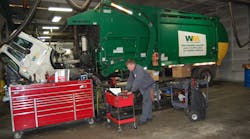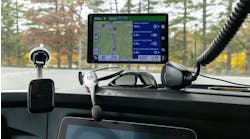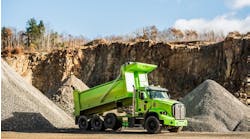The use of what’s called “big data” is helping a variety of industries solve a wide variety of problems before they actually develop – a capability that is increasingly being deployed in the commercial truck world to get ahead of maintenance e-related issues.
Richard Holada, VP-BI/AA for IBM’s Software Group, recently gave a group of fleet executives at the FleetRisk Advisors’ annual user group meeting a true insider’s view of the world of big data, predictive analytics, and the industries they are changing: airlines, government agencies, telecomm giants, automakers, the medical community, insurance providers, as well as truck fleets.
“Predictive analytics is all about taking a business problem [and addressing it],” he explained. “We pick a point in a process flow where, if we could be predictive, it would make a lot of difference. If predictive analytics works, you don’t even know it is there. It exists in the background.”
Holada was also careful, however, to remind the audience that predictive models are all about “propensities” not guarantees, and that humans have to act at the point of impact. “If I can predict the winning lottery number, but I don’t buy a ticket, it doesn’t matter,” he said.
Users of advanced analytics and predictive models are not just learning how to successfully make use of this access to better information, however, they are also demanding that this newest of business tools become more user friendly, engaging, flexible and interactive, according to Holada.
Brad Stinson, VP-engineering for truck component supplier Stemco, told Fleet Owner that wireless delivery of data combined with “cloud” data storage is one way predictive analytics is being made easier for truck fleets to tap into.
“We currently have a products within our BAT RF product line which collect data from wireless sensors mounted on each equipped wheel ends that can deliver information such as mileage, tire pressure (per tire) and temperature,” he noted. “This data can be aggregated, stored in our cloud and accessed via a web application or communicated into an existing solution.”
Stinson stressed that it is through such data that customers can see exactly where problems are occurring and whether specific vehicles are operating within the desired operating envelope.
“The benefit is that users are able to head off catastrophe and avoid trucks being sidelined through an event such as a blowout,” he added. “This predictive maintenance allows users to address issues before they become serious problems incurring higher costs.”
IBM’s Holada cited several examples of the benefits predictive analytics are providing in other industries:
- Reducing infection-caused mortality rates after heart valve replacement by 6%
- Helping a car company predict when engine block molds will go out of tolerance due to wear so that they can be replaced before blocks come out bad
- Enabling an insurance company to identify the few customers who are trying to cheat the system so that they can provide better, faster service to everyone else ---and reduce costs by not having to investigate every customer
- Identifying the string of events that lead up to airline catastrophes in order to better prevent accidents before they happen
- Reducing port costs for a car importer, by identifying when a shipload of vehicles will be at the port so that neither the army of people required to drive them off the ship nor the ship are kept in (extremely expensive) holding patterns
- Reducing costly customer “churn” for a leading telecomm company
- Pinging some 5,000 sensors onboard every car every hour for a luxury automaker to identify anomalies that may cause problems down the road
However, Stemco’s Stinson cautioned that many challenges remain ahead before true predictive maintenance based on such predictive analytic data streams is ubiquitously available to the trucking world.
“One issue is relaying the value proposition to customers, and demonstrating that if you invest into predictive maintenance systems you are going to eliminate cost and pain elsewhere,” he explained. “It’s the idea that extending tire life and eliminating roadside emergencies will pay for the implementation of the system. It’s extending maintenance cycles and avoiding over-maintenance because you know that you’re running within the desired envelope.”
Another challenge is optimized data communication. “When you move into the component area, such as for wheel ends, there are many players vying for that space. There’s no single industry standard to communicate that data,” Stinson said. “Often times wheel end monitoring uses one system while braking systems use another. Multiple electronic intelligent systems add to the cost, and the total sum becomes too high. There needs to be more collaboration within the industry between competitors to deliver an optimized price point.”
Predictive data also must be handled and viewed differently than in the past, argued IBM’s Holada, especially in terms of how businesses act upon in.
He explained that in the “traditional” model, the unknowns of the business environment would be addressed via a process that began with sensing and responding to a need, problem or opportunity; then using business instincts and intuition to guide actions—supported by more and more back-office analysis over time.
Predictive analytics changes all of that, noted Holada, with defining characteristics including: predicting versus sensing and acting in real time based upon facts, not intuition. In this “new” world, analytical expertise is also no longer the work of select back-room professionals; it is part of everybody’s job and it happens everywhere.
This also includes the need for what he called more and better data “visualizations.” In the predictive analytical world, Holada said “visualizations” is a broad and relatively new term for graphic displays of often very complex business information, which may include animation, coaching tools to make it faster and easier to address particular business problems with the visualization, or the opportunity to collaborate with others.
You remember bar graphs, pie charts and various work flow diagrams? Well, visualizations are taking over that old neighborhood and bring a lot of new functionality with them, he explained.
Indeed, managing data – not necessarily the gathering of it – is perhaps the key challenge where predictive analytics are concerned, Stemco’s Stinson emphasized. “The hurdles are not with the hardware [as] the technology is available,” he explained. “The real issue is with the processing and delivery of the information in a clear and actionable format where fleets will be able to readily act on the data.”
Cost is also going to be critical where predictive analytics is concerned as well, he said. “It all comes down to value, if it saves time and money, increases margins through vehicle uptime or otherwise makes maintenance processes easier, fleets will be interested,” Stinson added. “A clear ROI [return on investment] is important in order for fleets to move forward with this type of technology.”
And though IBM’s Holada is quick to stress that predictive analytics is not quite “there” yet in terms of all those capabilities, it’s already “stirring and kicking” in his view.
“Our goal is to apply analytics to optimize decisions at every contact point,” he said. “This will be made possible by enabling pervasive, predictive real-time decisions at the point of impact. You have to be able to take the performance and skills of the best experts and make that available to everyone.”



